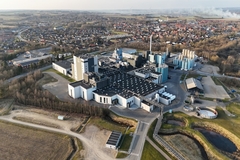
- Industry news
Industry news
- Category news
Category news
- Reports
- Key trends
- Multimedia
- Journal
- Events
- Suppliers
- Home
- Industry news
Industry news
- Category news
Category news
- Reports
- Key trends
- Multimedia
- Events
- Suppliers
Tamarack Biotics CEO on enhancing dairy sustainability and quality with UV light milk processing

Traditional heat-based milk pasteurization often leads to a loss in enzymes, proteins, and immunity-supporting compounds. US-based Tamarack Biotics’ FDA-approved novel UV light-based milk treatment process aims to overcome this challenge to pave the way for a “new generation of dairy products” that retain the full bioactive benefits of raw milk without the risk.
Tamarack’s TruActive process eliminates harmful pathogens while preserving the taste and creaminess of raw milk, and is also more sustainable than thermal processing since it uses less energy, states the company.
The FDA’s acceptance confirms that Tamarack’s method meets the official efficacy criteria for pasteurization. The company notes that this will allow it to initially be used in the production of powdered dairy ingredients, including whey protein concentrate, milk protein concentrate, and immune-supporting compounds like lactoferrin.

According to CEO Bob Comstock, proving this required the team to demonstrate three separate elements: ability to kill pathogens, the process’s effectiveness over the shelf life of the product at “normal and moderate abuse conditions,” and its ability to reduce pathogens at least as effectively as thermal pasteurization.
The team conducted the necessary experiments after agreeing with the FDA on the specifics.
“Interestingly, our process achieved, on average, a higher log reduction in all of the pathogens found in milk than heat does. So ultraviolet processing using our method is actually safer than heat, particularly with one pathogen that’s well known in Europe but not in the US — mycobacterium avium paratuberculosis (MAP),” Comstock tells Food Ingredients First.
 Comstock recently discussed the UV method’s FDA approval and milk quality benefits with us.He explains that MAP is a thermoresistant bacterium and often survives pasteurization, leading to food safety concerns.
Comstock recently discussed the UV method’s FDA approval and milk quality benefits with us.He explains that MAP is a thermoresistant bacterium and often survives pasteurization, leading to food safety concerns.
“Published research has recently shown that MAP can be found on store shelves with viable cells in the US and Europe, and while its link to Crohn’s disease is still debated, the key point is that traditional pasteurization is not effective against MAP. In contrast, our UV pasteurization process achieves a seven-log reduction, which is very important for food safety.”
Targeting pathogens with cold pasteurization
While pasteurization is usually done at high temperatures, Tamarack’s process is done entirely cold with “no heat ever applied,” notes Comstock. Milk typically runs at 3-4 degrees Celsius and only rises a few degrees throughout the process.
This preserves bioactive compounds usually destroyed by heat, such as lactoferrin, immunoglobulins, and lactoperoxidase.
“All of our testing looks at the bioactive content of these proteins in dairy ingredients, and we have 2–30 times higher concentrations of these,” Comstock adds.
He further highlights the challenges of working with UV light to treat milk: “UV light doesn’t penetrate milk, and is almost a surface treatment technology. So we use very thin layers of milk and very highly turbulent flows.”
This constantly renews the milk’s surface on the quartz tube, a component of the UV treatment system made of quartz glass.
“So our turbulators are 1.5 meters long, and the milk flows at very high Reynolds numbers [a measure of flow turbulence] through these tubes to ensure the surface is continuously renewed and treated. And in this way, we can achieve the five-log reduction of the most UV-resistant pathogen,” he explains.
A five-log reduction means that for every 100,000 pathogens initially present in the milk, only one remains after treatment, making the milk much safer to consume.
Will UV light replace pasteurization?
Comstock believes that UV pasteurization will eventually replace all traditional pasteurization. In terms of sustainability, he highlights improvements in three factors.
 Tamarack’s TruActive UV technology eliminates pathogens while preserving milk enzymes, proteins, and immunity-supporting compounds (Image credit: Tamarack Biotics).“One is that a lot less energy is used. It takes considerable steam to heat up milk and then electricity to cool it back down. And with our process, there is very little energy use.”
Tamarack’s TruActive UV technology eliminates pathogens while preserving milk enzymes, proteins, and immunity-supporting compounds (Image credit: Tamarack Biotics).“One is that a lot less energy is used. It takes considerable steam to heat up milk and then electricity to cool it back down. And with our process, there is very little energy use.”
Secondly, Clean-in-Place chemical use is significantly reduced, leading to reduced foul smell. “Fouling is an enormous problem in a dairy processing plant, and you have to shut down at regular intervals for cleaning, but when milk is pasteurized with UV light, no fouling occurs.”
Further, since proteins are not denatured, the equipment stays clean after 12 hours of operation and a simple rinse. This also saves water, he shares.
“The third and the most important factor is the nutritional benefit. Milk is a unique biofluid, containing bioactive proteins that are beneficial for humans.” These proteins help trigger an infant’s immune system and can also restore immune function in older adults, as shown in a UC Davis, US, clinical trial.
When asked if the method could be applied to plant-based milk alternatives, Comstock says that even though the team has found it effective in dairy alternatives, they “don’t have the same challenges” as raw milk.
“You’re not trying to preserve any bioactive compounds in almond milk, since there aren’t any. There’s no lactoferrin to be found in almond milk. So there’s no justification to use UV in these nut milks,” he explains.
Unlocking milk’s health potential
After the FDA approval, Tamarack has been working with many dairy companies worldwide.
 The method preserves lactoferrin and immunoglobulins while retaining raw milk’s taste and creaminess.“We’ve had requests from Brazil, Mexico, Japan, and India. Everybody is aware of this now and wants to test it in their own facility, buy equipment, and put this process to use for the three reasons I described.”
The method preserves lactoferrin and immunoglobulins while retaining raw milk’s taste and creaminess.“We’ve had requests from Brazil, Mexico, Japan, and India. Everybody is aware of this now and wants to test it in their own facility, buy equipment, and put this process to use for the three reasons I described.”
The company has already started expanding TruActive to other dairy products such as cheese, yogurt, kefir, and colostrum.
It now aims to conduct more clinical trials to demonstrate the benefits of bioactive compounds in milk, which are destroyed by heat, says Comstock. “We’ve known for a long time that children who consume raw milk at a young age are protected from developing asthma, hay fever, eczema, atopic dermatitis, and food allergies.”
“We also have trials ongoing looking at gut health, microbiome, leaky gut, and other benefits, and think these compounds will provide and improve human health broadly. It’s surprising to me how powerful milk is as a compound, but unfortunately, we have been destroying it for so long in the name of safety. It’s exciting to be part of using milk now to improve human health,” he concludes.










